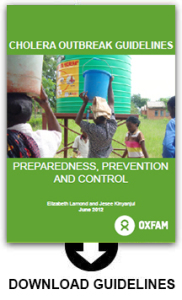This annotated bibliography has 11 journal articles and 1 fact sheet that were published from 1985 through August 2012 on boiling drinking water. Links to the full-text are included when possible. Please contact WASHplus if you have other studies and reports to add to this bibliography.
2012
1 – Boiling as Household Water Treatment in Cambodia: A Longitudinal Study of Boiling Practice and Microbiological Effectiveness, Am J Trop Med Hyg. 2012 Jul 23.
Brown J, Sobsey MD.Department of Disease Control, Faculty of Infectious and Tropical Diseases, London School of Hygiene and Tropical Medicine, London, United Kingdom; Department of Environmental Sciences and Engineering, Gillings School of Global Public Health, University of North Carolina, Chapel Hill, North Carolina.
This paper focuses on the consistency of use and microbiological effectiveness of boiling as it is practiced in rural Cambodia. We followed 60 randomly selected households in Kandal Province over 6 months to collect longitudinal data on water boiling practices and effectiveness in reducing Escherichia coli in household drinking water.
Despite > 90% of households reporting that they used boiling as a means of drinkingwater treatment, an average of only 31% of households had boiled water on hand at follow-up visits, suggesting that actual use may be lower than self-reported use. We collected 369 matched untreated and boiled water samples. Mean reduction of E. coli was 98.5%; 162 samples (44%) of boiled samples were free of E. coli (< 1 colony-forming unit [cfu]/100 mL), and 270 samples (73%) had < 10 cfu/100 mL. Storing boiledwater in a covered container was associated with safer product water than storage in an uncovered container.
2 – Prevalence of Anemia and Its Risk Factors Among Children 6–36 Months Old in Burma, Amer Jnl Trop Med Hyg, Aug 2012.
Ai Zhao, Yumei Zhang*, Ying Peng, Jiayin Li, Titi Yang, Zhaoyan Liu, Yanli Lv and Peiyu Wang*
Address correspondence to Yumei Zhang or Peiyu Wang, School of Public Health, Peking University Health Science Center, Beijing, 100191 China. E-mails: zhangyumei111@gmail.com or wpeiyupku@gmail.com
Anemia is a common nutritional problem, and it has a remarkably high prevalence rate in Southeast Asia. In this study, children from 6 to 36 months were investigated to determine (1) the prevalence of anemia and (2) risk factors associated with anemia. Convenience sampling was used to select three villages in three different regions in Burma. Hemoglobin and anthropometric indicators were measured for 872 children. Logistic regression analyses were used to determine factors associated with anemia.
The overall prevalence of anemia was 72.6%, with 40.0% having severe anemia. Predictors of anemia are a young age (P < 0.001), mother with anemia (P < 0.001), height-for-age Z score < −2 (P = 0.017), low family income (P < 0.001), mothers without primary education (P = 0.007), drinking unboiled water (P = 0.029), and fever in the last 3 months (P = 0.001). There is a high prevalence of anemia in children, and their nutritional status is quite poor. To control anemia, humanitarians and governments should launch comprehensive interventions.
2011
3 – Coping with poor water supplies: empirical evidence from Kathmandu, Nepal, J Water Health. 2011 Mar;9(1):143-58.
Katuwal H, Bohara AK. 1915 Roma Ave NE, University of New Mexico, MSC05 3060, Albuquerque, NM 87131, USA. katuwalh@unm.edu
The authors examined the demand for clean drinking water using treatment behaviors in Kathmandu, Nepal. Water supply is inadequate, unreliable and low quality. Households engage in several strategies to cope with the unreliable and poor quality of water supplies. Some of the major coping strategies are hauling, storing, and point-of-use treatment. Boiling, filtering, and use of Uro-guard are some of the major treatment methods.
Using Water Survey of Kathmandu, the authors estimated the effect of wealth, education, information, gender, caste/ethnicity and opinion about water quality on drinking water treatment behaviors. The results show that people tend to increase boiling and then filtering instead of only one method if they are wealthier. In addition, people boil and then filter instead of boiling only and filtering only if they think that waterdelivered to the tap is dirty. Exposure to information has the strongest effect in general for the selection of all available treatment modes.
4 – Assessing the microbiological performance and potential cost of boiling drinking water in urban Zambia, Environ Sci Technol. 2011 Jul 15;45(14):6095-101.
Psutka R, Peletz R, Michelo S, Kelly P, Clasen T. London School of Hygiene and Tropical Medicine, Keppel St., London WC1E 7H, United Kingdom.
Boiling is the most common method of disinfecting water in the home and the benchmark against which other point-of-use water treatment is measured. In a six-week study in peri-urban Zambia, we assessed the microbiological effectiveness and potential cost of boiling among 49 households without a water connection who reported “always” or “almost always” boiling their water before drinking it. Source and householddrinking water samples were compared weekly for thermotolerant coliforms (TTC), an indicator of fecal contamination. Demographics, costs, and other information were collected through surveys and structured observations. Drinking water samples taken at the household (geometric mean 7.2 TTC/100 mL, 95% CI, 5.4-9.7) were actually worse in microbiological quality than source water (geometric mean 4.0 TTC/100 mL, 95% CI, 3.1-5.1) (p < 0.001), although both are relatively low levels of contamination.
Only 60% of drinking water samples were reported to have actually been boiled at the time of collection from the home, suggesting over-reporting and inconsistent compliance. However, these samples were of no higher microbiological quality. Evidence suggests that water quality deteriorated after boiling due to lack of residual protection and unsafe storage and handling. The potential cost of fuel or electricity for boiling was estimated at 5% and 7% of income, respectively. In this setting where microbiological water quality was relatively good at the source, safe-storage practices that minimize recontamination may be more effective in managing the risk of disease from drinking water at a fraction of the cost of boiling.
[click to continue…]




